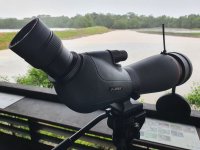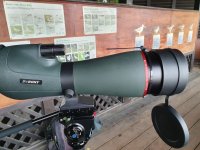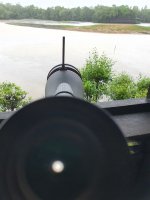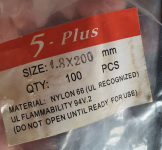KorHaan
Well-known member
On a rainy late afternoon, it seemed a good time to figure out the scope sight on our angled Zeiss 65.
It took a couple of times to see that cable A can't be tightly closed as the diagram suggests, as it forms an elliptical shape which locks it on to cable B, preventing A from being rotated to a viewing position (at least with the cable ties I'm using).
It's difficult to get the stub of cable B into a completely horizontal position, causing cable A (when raised to its vertical position) to be slightly offset to the left. Doesn't seem to make much of a difference in actual use.
With eyeglasses, it's impossible to just move your eyes when alternating between the eyepiece and sight. With a dominant left eye, if I put the tip of my nose at 3:00 o'clock on the eyecup, sighting over the tip of the sight, and then rotate my head down and forward, it works.
Thanks.
Mike Penfold
Hello, Mike,
Thank you for posting your findings, much appreciated!
It seems you're having a problem with the cable-ties you are using; I've just re-read Folkerts original posting on the Dutch forum, and also looked closely at the three photographs of his set-up on the Nikon ED50. They're in the second link of my post 1 in this thread.
Folkert states, in his original post, that if you pull the cable-ties real tight, it should work, the sighting A should - as he describes - ' click in ' between the heads of B and C. It could mean, that he and you are using different ties.
If you look at his photo's of his set-up, could you tell me if the ties that you are using are different in any way? The heads of the ties Folkert is using are tapered, slightly conical. This may be the reason that it works for him splendidly.
As for not getting the stub of B into a horizontal position, so that the vertical cable A is slightly offset to the left, may I suggest that you can slightly shift the entire ring set-up to the right? Would that make a difference? ( I'm guessing here, trying to come up with a solution that might make it work for you.)
Actually using the sighting device with glasses can indeed be difficult; I wear specs and I have owned an angled Zeiss 65, like you, but with the original 1-cable tie sighting I could hold my head in the adviced position, albeit a little awkward to not look against the rim of my specs. I take it, this is your problem also; for this nuisance I'm afraid I've no solution ready, I'm really feeling sorry you experience difficulties with this new tie set-up.
Have you used the original, 1-tie sighting on your Zeiss? The 'fixed' one as opposed to the collapsable one, I mean?
I hope more posters will share their thoughts, so maybe we can find a solution that's satisfying for you. I would really like that.
Best regards,
Ronald











